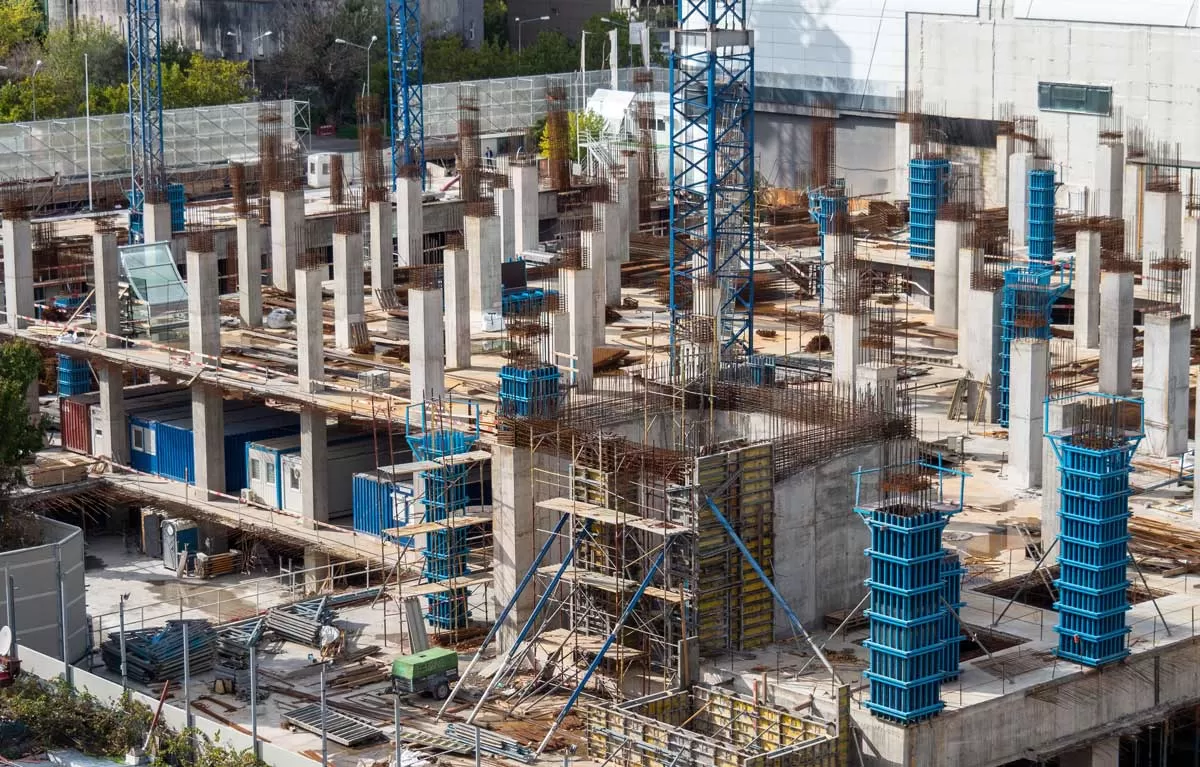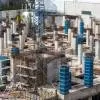- Home
- Infrastructure Transport
- ROADS & HIGHWAYS
- Budget Reactions - Construction
Budget Reactions - Construction
- One time 6 months partial guarantee from government to PSU banks to buy high rated pool of assets up to one lakh crore will provide the much needed liquidity to those NBFCs/HFCs having available assets. Shifting Regulation of HFCs from NHB to RBI is an important step to give confidence to the domestic and foreign investors.
- Doing away with the requirement of maintaining redemption reserve fund for public issuance of NCDs.
- Considering the long pending request of extending same tax treatment on bad loans available to bank to NBFC/HFCs.
- Investment by FII and FPI in debt paper of NBFCs will increase flows of long term funds.
- Setting of Credit Enhancements Corporation will deepen the long term bond market.
- Big push to affordable housing-rural in providing 1.95 crore homes.
- Additional 1.50 lakh tax exemptions on interest payment on housing loans over existing 2 lakh is a big relief to home loan takers.
- Infusing 70,000 crore in recapitalisation of PSU banks will enhance their lending ability to housing and other sectors.
- Government’s decision to raise borrowing from overseas will reduce dependence on banks which will increase private investment while supporting directly and indirectly the wide ranging sectors to fuel economy.
- Fiscal prudence is adhered to with fiscal deficit at 3.3.
- Himanshu Chaturvedi,Himanshu Chaturvedi
- Tata Projects
- Bharatmala
- Sagarmala
- UDAN
- BharatNet
- Sanjay Dutt
- REITs
- INVITs
- NBFC
- GST
- Thornton Advisory
- Neeraj Sharma
- Alok Deora
- YES Securities
- Suramya Nevatia
- SPV
- PPP
- JCB India
- Vipin Sondhi
- Asian Granito India
- Kamlesh Patel,Ratul Puri,Hindustan Powerprojects
- Sanjay Aggarwal
- Nirmala Sitharaman
- Maxson Lewis
- Magenta Power
- CleanMax Solar
- Nikunj Ghodawat
- KEI Industries
- Anil Gupta
- Hemant Kanoria
- Srei Infrastructure Finance
- International Copper Association
- Sanjeev Ranjan
CONTRACTORSHimanshu Chaturvedi, Chief Strategy Officer, Tata Projects“We appreciate the government’s intention to invest Rs 100 lakh crore into infrastructure in the next five years. This will ensure long term growth for the infrastructure sector and spur national development, including improving people’s lives through better amenities and facilities.The budget has paid attention to the issue of funding for long term infrastructure projects through the setting-up of an expert committee thereby spurring expectation that it can be resolved in the near future.Increased focus on railway network, especially modernisation of stations is a much needed initiative. Intent to upgrade 1.25 lakh km of rural roads at an estimated cost of Rs 80,250 crore will provide fillip to the rural economy, provide jobs and ensure development. Emphasis on other transportation initiatives such as Bharatmala, Sagarmala and UDAN can ease people's lives and provide stimulus to businesses.‘One nation one grid’ and other power sector initiatives such as tariff reforms can potentially rejuvenate the sector. Building of homes in both – rural and urban areas, and additional tax benefits for home loans will give a boost to the realty sector. Usage of Universal Services Obligation Fund corpus for augmenting BharatNet, especially in rural areas, is a noteworthy action. The setting up of National Space India, a PSU to boost commercialisation of India's space research will provide an impetus to India’s space ambitions, augment revenues and benefit the entire eco-system, including all vendors.”Sanjay Dutt, Managing Director & CEO, Tata Realty & Infrastructure “The 2019 Budget has come as a mixed bag for the real estate sector at a time when the industry is showing signs of revival. The government introduced schemes such as 'Bharatmala', 'Sagarmala' and UDAN have helped in improving the country’s infrastructure. Additionally, the availability of land belonging to CPSEs and central ministries to public infrastructure and affordable housing is expected to provide the much-needed impetus to the housing demand.The allowance of FIIs and FPIs to subscribe to REITs and INVITs would lead to an influx of investment in the cash strapped sector. The government’s assurance to provide one-time credit guarantee for the first loss up to 10 per cent for purchase of high rates pooled assets of financially sound NBFCs will further help the cause.The expected reforms in the rental laws along with the finalisation of the model tenancy law looks promising. In the affordable housing segment, the tax deductions of Rs 3.5 lakh on loans borrowed up to March 31, 2020, for homes valued up to Rs 45 lakh takes the government’s Housing for All by 2022 initiative one notch ahead.The fully automated GST refund module, which is likely to come soon, along with interchangeability of PAN and Aadhar provides much-needed flexibility to the real estate community.We believe the liquidity concerns of the developers could have been addressed with the reintroduction of Input Tax Credit for under construction properties. However, this year’s budget highlights the government’s intention to further strengthen the economy.”CONSULTANTNeeraj Sharma, Director, Grant Thornton Advisory “The Government has kept its focus intact on ‘Housing for All’ by announcing interest incentives for purchase of affordable housing and also creating additional land held by public enterprises for affordable housing. The announcement of reforms for promoting rental housing is encouraging for the real estate sector.”RAILWAYSAlok Deora, Vice President-Institutional Research, YES SecuritiesThe higher allocations towards Railways segment at ~Rs.1.6 trn in FY20 (~Rs.1.38 trn in FY19) would provide further boost to the sector. It would lead to more projects being awarded and higher business opportunities for key players like RVNL, Rites Ltd, Ircon International. Similarly the higher allocations towards road segment ~Rs.1.5 trn in FY20 (~Rs.1.3 trn in FY19) would lead to higher awarding in line with the Bharatmala Programme. Some of the key players to benefit include PNC Infratech, KNR Constructions, Sadbhav Engineering, Dilip Buildcon.Suramya Nevatia, CEO, Hind Rectifiers“One of the key highlights of the Union Budget 2019-2020 is emphasis on Indian Railways and infrastructure. For our economy, connectivity is an indispensable factor. With regards to the programme, heavy investment efforts were evidenced in SPV structures such as RRTS and proposed on the Delhi - Meerut route. Furthermore, PPP initiatives as well as TOD were encouraged and completion of sanctioned works/projects were emphasised. These projects would ensure more freedom for passenger trains in the existing railway network. The government has given a massive push to Indian railways by shedding light that an estimated investment of Rs. 50 lakh crore is required between 2018-2030. The proposal that a public private partnership (PPP) be used to unleash faster development and delivery of passenger freight services for railway projects will boost connectivity”.EQUIPMENTVipin Sondhi, Managing Director and CEO, JCB IndiaThe Union Budget presented by the government is about India's long term vision. It addresses the many factors required for our country to become a $5 trillion economy in a few years from now. The budget aims at building India's capability across sectors. Vital among them is the creation of social infrastructure, which would thus lead to an improvement in the ease of living. In addition to urban India, it has kept rural India and agriculture in focus. An allocation of Rs 80,000 crore for rural roads, will improve connectivity and will also create opportunities for trade and employment for youth. The budget also brings to forth the thrust towards building a sustainable environment with a strong focus on water management through the 'Har Ghar Jal' initiative. Moreover, it addresses the aspect of electric mobility as well and intends create an ecosystem for it to scale up. The budget touched upon the importance of growth for MSMEs to improve exports through innovation. With infrastructure growth being vital to achieve all of the above, a revival of the PPP, structural reforms in asset monetisation and a notable provision for infrastructure with improved liquidity over the next few years is welcome.”TILES, CERAMICS, SANITARYWAREKamlesh Patel, Chairman and Managing Director, Asian Granito India We welcome the budget proposals announced for the growth of tiles and marble business. The finance minister’s proposal to increase basic customs duty on tile and ceramic products to 15 per cent from existing 10 per cent will safeguard the domestic ceramic tile industry from the cheap imports and will strengthen the domestic industry. To address the problem of duty inversion, custom duty on Marble slabs is doubled to 40 per cent from 20 per cent currently. Tax reforms and tax simplification measures especially moving to electronic invoice system from January 2020 will significantly reduce the compliance issues. The budget proposals along with government move last year reducing GST on tiles, marble and granite to 18 per cent slab will give a much needed boost and provide the tiles and marble industry a level playing field. Enhanced interest deduction up to Rs 3.5 lakh for purchase of affordable house will translate into a benefit of around 7 lakh to the middle class home-buyers and help in achieving 'Housing for All'. Indian Ceramic industry would aim for a green and environment complaint industry and will continue to play an important role in the economic growth in the future and aim for global leadership in the industry and success of 'Make in India'. Sanitation coverage in rural India has gone up from 42 per cent in October 2014 to over 70 per cent and we hope that we should soon achieve maximum coverage. Tiles industry in India is estimated at around Rs 35,000 crore to Rs 40,000 crore and growing at healthy single-digit employing over 6 lakh people in direct and indirect employment.POWERRatul Puri, Chairman, Hindustan Powerprojects “The Company congratulates the Hon. Finance Minister on the progressive budget presented today.The power sector being the fuel and a major part of the economy affects various other sectors in a direct or indirect way. We are encouraged by the varied interventions of the government towards power tariff and the One Nation, One Grid model that will ensure power connectivity to various states at affordable rates. The government’s announcement to improve and discuss the UDAY-II scheme for a better financial and operational turnaround of discoms will help various other inter-linked sectors to grow and enhance their structure to better suit the needs of its beneficiaries.We appreciate the government’s intent to support the renewable sector through the tax deduction for production of lithium storage, solar PVs and other equipment as well as the allocation of more than INR 3,900 crore for wind and solar power. India is in the path of maximizing its renewable energy potential in line with its commitments towards mitigation of climate change.We are hopeful that all stakeholders will work together to help India achieve its renewable energy goal.”Sanjay Aggarwal, Managing Director, Fortum India “The Union Budget presented by the Hon’ble Minister Nirmala Sitharaman today clearly demonstrates the government’s vision of putting India on a growth trajectory. Fortum India appreciates the various steps taken by the government in addressing the issues related to tax and duties in the renewable sector and electric mobility. As Fortum India proceeds in setting up fast-charging EV infrastructure in India, the reduction in GST and import duties will accelerate the deployment and usage of electric vehicles in India. We now see a lot of action in the electric mobility, charging and storage space in line with the government’s green vision, which is very encouraging for the industry. We at Fortum wish to collaboratively work with vigour towards government’s aim of having 30 per cent electric vehicles by 2030, by continuing our investments in recycling the capital.”Maxson Lewis, Managing Director, Magenta Power The budget is a positive push for adoption of electric vehicles in India and is in line with the series of steps taken and announcements in that direction. Namely on four counts – three direct and one indirect aspect are important from that perspective. While the total cost of ownership was always in favour of EV, the announcement in the reduction of GST rate on electric vehicles from 12 per cent to 5 per cent reduces the upfront higher cost as against an ICE engine and improves the buying decision in favour of EVs. The additional income tax deduction of Rs 1.5 lakh on interest on loans taken to purchase electric vehicles is a bonus and the industry had not anticipated that. Credits to the government for this innovative idea to push for EV. A day ahead of the budget 2019, the government lowered customs duty on import of parts and components. This will drive domestic assembling of electric vehicles, which today is plagued by Chinese imports and is actually hurting the EV industry. The EV industry primarily belongs to start ups and will not be the domain of large monoliths. The push to simply and support the Start Up ecosystem will in effect push the EV growth a lot faster.Nikunj Ghodawat, Chief Financial Officer, CleanMax Solar “Our response to the Union Budget 2018-19 is slightly indifferent. The government is focusing on providing impetus to EV infrastructure and this will help develop the segment over a long term. Initiative to boost liquidity for the NBFC sector and further capitalization of bank will certainly help and its in-line with our demand for bringing in more liquidity into the system, which will help revive the capital investment. Another important takeaway for us is the tax exemption for domestic manufacturers of solar cells, modules and EVs. We expect this to bring down prices of domestic solar modules and batteries. Also there was emphasis to bring structural reforms in power sector to remove barriers, cross subsidy and undesirable duties is positive, which shall help direct sourcing of renewable power by large corporate customers, but the fine print is still awaited. However, overall reduction on corporate tax rate would have been more welcomed.Anil Gupta, Chairman & Managing Director, KEI Industries “We would appreciate development centric forward looking budget, which will impact every household of the country and industry will witness new horizon of development. The maiden Budget has laid special emphasis on the much awaited infrastructural development where the Government will invest Rs 100 Lakh crores in this segment for the next five years. The power sector has seen phenomenal growth achieving the electrification of almost 96% of households in the last 5 years. This large growth in the sector can be attributed to the infrastructure boom in India creating more avenues for companies like ours. Investments in railways, housing and farm are paramount to overall infra-growth for our company. The Government is also planning to invest 50 Lakh crores for Railways which will further boost the demand resulting in expansion of our business. Furthermore, the Government has shed light on the plan of One nation, One Grid & the Pradhan Mantri Gram Sadak Yojna will be a standalone element in ensuring power connectivity at affordable rates.”FINANCEHemant Kanoria, Chairman, Srei Infrastructure Finance The Finance Minister has covered almost all sectors in this budget, from agriculture to infrastructure to financial sector and many others. She has pressed a number of right buttons – be it in terms of talking about a new education policy to revamp the education and skilling ecosystem, or steps towards mitigating the owes of the financial sector, or the plans to step up infrastructure creation. Once the details of implementation get unfolded over a period of time, further clarity will emerge. As the present government is in continuity, therefore, this budget aims to build on various policy reforms already undertaken by this government over the last five years. The target investment figure of Rs. 100 trillion for infrastructure over a 5-year horizon will surely be encouraging for the country. This only re-emphasizes this government’s continued infrastructure focus. The announcements towards creation of national grids for power, water, gas, internet set the tone for the building of a vibrant, new India and such steps will definitely improve the standard of living for the masses in a significant way. Adequate emphasis has been laid on the improvement of connectivity through enlarging the network of roads and waterways, creation of more regional airports and undertaking a massive railway expansion plan. Equally important is the announcement of building domestic capability and capacity in maintenance-repair-overhaul (MRO) in the aviation sector. The kind of sops that have been announced for affordable housing (with valuation up to Rs 45 lakh) will provide a big boost to the housing sector. Not only will all these create huge number of jobs, both skilled and unskilled, but also create demand for other ancillary industries downstream. This large envisaged investment in infrastructure sector has not specifically mentioned the role of the private sector, which we presume will be announced in due course. The announcement that the government is exploring external markets for borrowing, coupled with a number of initiatives aimed easing the inflow of foreign capital in Indian entities seem to be a conscious effort to tap the abundant low-cost global capital which is on the lookout for good investment options. This is again another well intentioned move, given the current difficulties in accessing credit domestically. Given the importance of the NBFC sector in the economy and the kind of liquidity problems they are facing, we are happy that the FM has announced several measures for this sector. In particular, we are enthused about the announcement of a one-time 6-month partial guarantee of Rs. 1 lakh crore extended to state-run banks for purchasing consolidated pooled assets of financially-sound NBFCs. This is indeed a timely move. And almost immediately after the budget presentation, the Reserve Bank of India came out with a statement that it will provide required liquidity backstop to the banks against their excess G-sec holdings. A circular in this regard will be issued separately. We still hope to hear some news on the medium to long term measures for NBFCs to continuously raise resources for their ongoing operations. Overall, the budget has covered many aspects broadly and may be due to paucity of time, the numbers and also the implementation steps have not been articulated as yet.Deo Shankar Tripathi, Managing Director and CEO, Aadhar Housing FinanceThe Budget has covered wide range of activities to give boost to the economy and to encourage foreign investment. Various measures, as under, are proposed to address immediate and long term liquidity issues of NBFC/HFC.One time 6 months partial guarantee from government to PSU banks to buy high rated pool of assets up to one lakh crore will provide the much needed liquidity to those NBFCs/HFCs having available assets. Shifting Regulation of HFCs from NHB to RBI is an important step to give confidence to the domestic and foreign investors.Doing away with the requirement of maintaining redemption reserve fund for public issuance of NCDs.Considering the long pending request of extending same tax treatment on bad loans available to bank to NBFC/HFCs.Investment by FII and FPI in debt paper of NBFCs will increase flows of long term funds.Setting of Credit Enhancements Corporation will deepen the long term bond market.Big push to affordable housing-rural in providing 1.95 crore homes.Additional 1.50 lakh tax exemptions on interest payment on housing loans over existing 2 lakh is a big relief to home loan takers.Infusing 70,000 crore in recapitalisation of PSU banks will enhance their lending ability to housing and other sectors.Government’s decision to raise borrowing from overseas will reduce dependence on banks which will increase private investment while supporting directly and indirectly the wide ranging sectors to fuel economy.Fiscal prudence is adhered to with fiscal deficit at 3.3.Manish Sheth, Managing Director & CEO, JM Financial Home Loans After a supportive interim budget in February 2019, the union budget 2019-20 has reiterated government’s push towards ‘Housing for all’. Government’s focus on providing MUDRA loans to common man and creating employment opportunities will enable people to own a house. Further, the incremental tax deduction of Rs 1.5 lakh for interest paid on home loans for purchase of houses up to Rs 45 lakh will provide the much-needed impetus to the affordable housing segment in India. The budget proposal will also drive demand for affordable housing in the Tier-1 and Tier-2 towns. On the liabilities side, exemption from creating DRR on funds raised by way of public issue of NCDs by NBFCs is also welcome move.COPPERSanjeev Ranjan, Managing Director, International Copper Association “The Union Budget 2019-20 presented by the Finance Minister is positive and supports the ambition of the Country as a USD$ 5 Trillion economy over the next five years. We were enthused at the announcement of One Nation, One Grid that will ensure power availability at affordable rates. While this is extremely heartening we would appreciate that the government also pay attention to the quality of power being distributed and raise the efficiency of the grid and reduce economic losses. Further the ‘House for all by 2022’ mission and additional tax benefits for home owners will enhance access to affordable housing. Encouraging EV adoption in India by incentivising the purchase of electric vehicles and developing charging infrastructure. With further support of lower GST rates and income tax incentives, electric vehicles will become affordable and accessible to the consumers. We welcome the announcements as the government works towards reduction in India’s carbon footprint.”

The Only Way is Up!
In 2025, India’s real-estate market will be driven by a confluence of economic, demographic and policy-driven factors. Among these, Boman Irani, President, CREDAI National, counts rapid urbanisation, the rise of the middle class, policy reforms like RERA and GST rationalisation, and the Government’s decision to allow 100 per cent FDI in construction development projects (including townships, housing, built-up infrastructure, and real-estate broking services).In the top metros, especially Bengaluru, followed by Hyderabad and Pune, the key drivers will continue to be job creation a..

Organisations valuing gender diversity achieve higher profitability
The building materials industry is projected to grow by 8-12 per cent over the next five years. How is Aparna Enterprises positioning itself to leverage this momentum and solidify its market presence?The Indian construction and building materials industry is projected to witness significant expansion, with estimates suggesting an 8-12 per cent compound annual growth rate (CAGR) over the next five years. This growth is fuelled by rapid urbanisation, increased infrastructure investments and sustainability-focused policies. With India's real-estate market expected to reach $ 1 trillion by 2030, t..

Dealing with Delays
Delays have beleaguered many a construction project in India, hampering the country from building to its ability and potential, and leading to additional costs incurred by the contractor. The reasons for delayIn India, delays mainly occur owing to obtaining statutory approvals, non-provisioning of right of way, utility diversion and approval of drawings and design. Delays are broadly classified based on responsibility and effect. Excusable delays arise from factors beyond the contractor’s control, such as force majeure events or employer-induced delays. These delays generally entitle th..
Latest Updates
Recommended for you
Subscribe to Our Newsletter
Get daily newsletters around different themes from Construction world.
Advertisement
Advertisement
subscribe to the newsletter
Don't miss out on valuable insights and opportunities
to connect with like minded professionals














